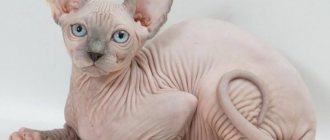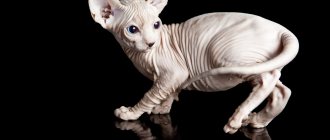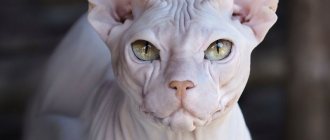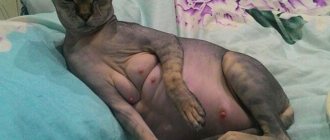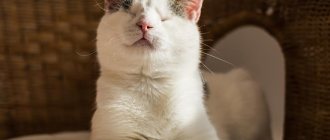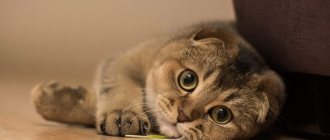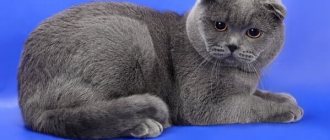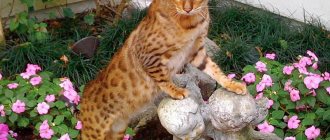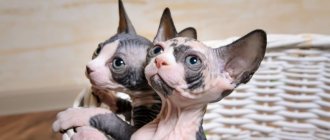Fans of meowing creatures do not always realize how great the variety of pets is: amazing hairless cats
, for example, are also divided into several breeds. Various historical sources provide little information on the history of furless creatures. They say that such pussies were known during the times of the Mayan Indians, although written evidence of the existence of hairless cats dates back only to the beginning of the 19th century: a description of cats lacking fur was given by the naturalist Johan Rudolf Rengger.
In 1903, Nellie and Dick, a pair of cats without hair, were bought from the Mexican Indians. But the new owners did not expect offspring.
As legends and myths say, a hairless cat is a sacred creature. The popularity of such a pussy is obvious: many people liked the hypoallergenic, hairless creatures with a particularly interesting character.
For some, it remains surprising that hairless kittens with an exotic appearance can appear from an ordinary cat with short hair, even if she is a Siamese breed. But about where hairless cats come from, below.
How the Sphynx breed was developed
Hairless Sphynx cats got their name from the famous mythical guardian of the pyramids because of their appearance. Attracting a whole range of eyes, they have gained incredible popularity among feline fans. But few people know that the breed was first mentioned many years ago in ancient papers. These exotic creatures were sacred.
Today, there are several breeds of Sphynx cats, which create one type of hairless cat. The breed of Canadian cats without fur appeared at the moment when an inconspicuous cat gave birth to a hairless kitten. After numerous studies, it was discovered that a special gene was inherited, which in turn is responsible for the lack of hair.
The Don breed of hairless cats was also discovered by chance. They tried to cure the cat, which was found on the street, for a long time, but it turned out that the pet was completely healthy. Her offspring were also distinguished by their lack of hair from other cats.
After some time, as a result of crossing the Don breed and a shorthair cat, a new line of the genus of all St. Petersburg hairless cats arose.
Origin
The gene that leads to the absence of fur in a cat has been manifesting itself for a long time. Hairless kittens have occasionally been born to representatives of various cat breeds. The owners perceived such pets as a funny misunderstanding.
The first described pair of hairless pets was bought by Mr. Shinnik in Mexico from local Indians. The owner was unable to obtain offspring from the strange animals, but left a detailed description of the animals, which made further research possible.
Soon a hypothesis arose that hairless seals are descendants of animals brought from Europe to South America in the 15th century. The loss of wool could be provoked by a sharp change in climatic conditions.
Later, in the 20th century, Siamese cats living in France began to have kittens without hair. Breeders tried to crossbreed these animals in order to consolidate the species trait, but the attempts remained unsuccessful.
At the origins of the breed of modern hairless cats is a Canadian cat, born in 1966. The descendants of the cat received the common name Sphinxes, due to their resemblance to ancient Egyptian images. Many researchers are confident that ancient sculptures in the Egyptian desert are images of hairless cats.
Thanks to their unique grace, cats without fur are becoming increasingly popular. The following describes the standards and varieties of breeds of these graceful creatures.
Photo of the Sphinx
Description and general breed standard
The Sphynx cat is naturally endowed with a slender and, not surprisingly, strong and muscular body. The main difference is, of course, the skin, which has no hair or barely noticeable cover.
It is a mistake to assume that all representatives of this breed are bald - the Sphynx with hair is not new for a long time.
What also makes the Sphynx stand out is its large, slightly pointed, erect ears and almond-shaped eyes. The head is diamond-shaped. The nose is straight and flat. In general, such an elegant muzzle is a bit reminiscent of unearthly creatures. The slender, flexible body flows smoothly into long limbs and a straight, thin tail.
The color of the sphinx can be completely different: plain, spotted, two-color, bicolor (when in addition to one main shade there is another color). Also, a cat can simply tan, thereby changing color.
As for the pregnancy of Sphynx cats, it proceeds quite favorably and calmly. During this period, you should not introduce the expectant mother to new foods, but you need to feed her more often. Despite the uniqueness of the breed, a pregnant Sphynx cat needs the same care as all felines during this period. Between two and five kittens are born in a litter.
Tortoiseshells (totrie)
The spotted tortoiseshell color of Totrie with red-red and cream markings is more characteristic of female Sphynx cats. They are very rare in males and are considered a deviation.
The variation and proportions of pigmentation are different:
- "Black Carapace": Black and tawny spots cover the Sphynx's skin throughout the body.
- “Blue and Cream”: Blue-blue spots mixed with cream color.
- “Chocolate Shell”: A rich, bright chestnut brown shade with flecks of red.
- “Cinnamon”: Reddish-reddish flecks mixed with cinnamon-colored spots.
- "Mauve Turtle": Cream flecks are placed on a light lavender, lilac shade.
- “Natural Faun”: The cream color of the sphinx’s skin is decorated with cream spots.
Features of the Sphynx breed (comparative table of species)
| View | Canadian | Donskoy | Petersburg |
| Head | Slightly long head. Straight and flat nose. There is a depression between the nose and forehead. Pronounced cheekbones. The neck is not too long and muscular. | Pronounced brow ridges. There are vertical folds on the flat forehead. There are also folds on the head and neck. The nose is straight and flat. | Diamond shaped head. The forehead is flat. The profile is slightly convex. The neck is thin and long. The cheekbones are flat, not sharply expressed. |
| Ears | Erect and wide. | Slightly tilted forward. Wide, with rounded ends. | Slightly pointed tips. The wide ears are set far apart. |
| Eyes | Wide, almond-shaped, slightly slanting. Color may vary. | Almond-shaped, there is an inversion of the eyelids. The color can be any. | Small, almond-shaped. The color is often bright green or blue, but blue is also possible. |
| Body | Flexible, muscular body of medium size, soft and very warm. The tail is long and straight. | ||
| Weight | 3-5 kg | ||
| Cover | Elastic and thick. To the touch it resembles suede, the length is no more than 2 mm. | Elastic and soft, hot to the touch, folds present. In cold weather, it may become covered with fluff in some areas. | Elastic, has a large number of folds, especially on the head. Hot to the touch. |
| Color | Can be varied. There are both single-color and two-color spotted sphinxes. | ||
Solid color
The different shades of sphinxes are actually the skin's own pigmentation and a thin layer of mossy down. When exposed to sunlight, a cat may tan and its color will become brighter.
Let's look at the main types of Sphynx colors:
| Black | The tone of the Canadian Sphynx is black and one-level. The skin of the nose is black, the skin of the paw pads is black or brown. |
| Blue | Shimmers from blue to blue. The nose and paw pads are dark blue. |
| Red (Red) | Deep shade, rich, brilliant red-red color. The lips, chin, nose and paw pads are red brick. |
| White | The color shimmers from white to pink. The nose of the white Canadian Sphynx has a pink tint, and the pads of its paws are the same color. |
| Cream | Single level cream shade. The skin of the nose and paw pads is also pink. |
| Chocolate | Chestnut-chocolate, rich color. The nose and paw pads are brownish. |
| Lilac | The shade is grayish with a mauve tint. The nose and paw pads of the Sphinx are pinkish-lilac. |
Sphynx cat character
At first glance, if you look at a photo of a Sphynx cat, it may seem that the pet is very unfriendly and rude. In fact, Sphynx cats have a character characterized by unimaginable warmth and love for their owner; they are very bored in his absence.
Cats quickly get along with other pets, if any, and show care and friendliness, not even allowing the thought of causing harm. They get along well with children, because they love to be the center of attention. Pets are amenable to swaddling in children's games and will not be angry if a child decides to decorate a cat's body with a design.
Sphynx cats are one of the most peaceful, unforgiving and altruistic breeds. Despite all the significant advantages, if you don’t give your kitten enough attention and affection, the animal can become embittered and aggressive.
Calico CALICO
Varieties:
- White CALICO: white with spots of black and tan. White color predominates on the lower parts of the body.
- Van CALICO: white shade mixed with red and black spots, present on the limbs, head, tail. One or two small spots of color on the body are allowed.
- Dilute CALICO: white color with grayish-blue, cream spots. Predominant on the lower parts of the sphinx's body.
- Dilute Van CALICO: white with blue, cream, red spots located on the legs, tail and head. One or two small spots of color on the body are allowed.
Care and maintenance of sphinxes
Since the Sphynx kitten is naturally hairless, you must remember and follow the rules for caring for your pet. The Sphynx's skin secretes a certain lubricant, in other words, sweat, in order to maintain its elasticity. The owner needs to remove excess moisture from the skin every day and bathe his pet frequently. Otherwise, the cat will begin to leave brown spots with a very unpleasant odor wherever he decides to lie down, that is, everywhere.
Ears need to be washed regularly. The skin in these areas is quite thin; it should be treated delicately with a special lotion. Since the eyes are not endowed with eyelashes, they must be wiped daily.
The average body temperature of a Sphynx cat is 38-39 degrees. However, owners should not forget that their pet is deprived of fur and during the cold period it is necessary to stock up on warm clothes. Otherwise, your pet may catch a cold. Also, your pet may get burned if it stays near the battery for a long time.
Kittens' teeth and claws should be cleaned with gauze soaked in herbal infusion. For adult cats, it wouldn’t hurt to buy a special brush and suitable toothpaste. For claws, a file is required to properly grind, as well as special scissors that will allow this procedure to be carried out as efficiently and accurately as possible.
Nutrition
In order to help prolong a cat's life, it is necessary to maintain proper nutrition. What to feed a Sphynx cat? It is worth giving preference to a combined diet. There are some foods that are prohibited for sphinxes: onions, potatoes, fatty meats, sweets and fried foods. Otherwise, you can follow the general rules for all cats.
A special feature of this breed is its appetite: the cat loves to indulge in gluttony and after a good portion can continue to ask for a treat. Do not overdo it and monitor the animal’s daily food intake.
Cost of kittens
For those planning to purchase a Canadian Sphynx, you should consider the following features:
- Specifics of the content.
- The specificity of the species - not everyone likes it. It is worth considering that Sphynx kittens may look cuter than adult representatives of this breed.
The price for kittens reaches 10,000 rubles.
Health and breed diseases
Today's sphinxes have good immunity. Anyone can get sick, but in order to avoid suffering for the pet and wasting the owner’s nerves, vaccination should be carried out in a timely manner. According to the vaccination calendar, the first one is given at 8 months of age, then at a year and beyond.
The most common diseases of sphinxes are:
- Turning of the eyelids (entropion). It occurs quite often and does not occur in the mildest form. If you notice watery eyes, do not self-medicate and consult a specialist. This disease can lead to vision loss.
- Skin diseases. Due to the lack of fur, this breed is prone to dermatitis and acne.
- Gastrointestinal diseases and obesity. These problems can arise due to improper nutrition or overfeeding of the animal.
- Ear mite. Check your pet's ears periodically and notice if he scratches them excessively.
- Lichen. This disease is a common problem in hairless cats. Monitor the condition of your skin and if any foreign spots appear, consult a doctor.
Rare colors
In addition to the standard categories, there are also rare colors of sphinxes: Siamese color point, mink, sable, champagne, platinum. Small and teenage kittens have a lighter body color. With age, the color becomes darker, more distinct, and the full range of colors can develop up to eighteen months.
Siamese color point
The color is very similar to the color scheme of Siamese cats. The tips of the paws, ears, nose and tail are of a darker shade. There are marks on the muzzle. Sphinxes have darker and lighter areas of the body. Sphynx kittens are born with blue eyes and have a recessive gene.
Mink
Newborn kittens have a light color, and as they grow older they acquire a certain color scheme. The fur darkens and becomes solid.
Variety of mink shades:
- natural chestnut;
- blue;
- champagne;
- platinum mink;
- tabby mink;
- tortoiseshell totrie;
- white mink.
Sable (sepia)
Sable is a color that is formed in the younger generation. Sable has a reddish-brown color scheme, named after the rich brown pigment obtained from the ink sac of the common cuttlefish Sepia.
A mature Sphynx has a rich, warm brown sable color without shading, spots, speckles or markings of any kind. Kittens are born lighter. The skin on the nose and pads of the limbs are brown. The eyes are bright green with a golden tint.
Champagne
The name of the sphinx color is given for the various pale shades of yellowish-orange color, close to the beige color scheme; comes from the typical color of the drink. An adult cat has a warm copper, honey-beige tone, clean, without marks or specks. The skin of the nose is soft brown, and the pads of the paws have a brownish-pink tint.
How much does a Sphinx cost and where to buy it?
The cost of a kitten depends on the purity of the breed and the purpose of purchase. The price varies from $100 to $5000. The cost of kittens on the Internet can be $100-150, but it is unlikely that anyone will sell purebred kittens at that price. The opportunity to purchase a purebred family member as a pet will cost $400-800. If the kitten is needed for breeding, then the amount will increase significantly. Moreover, a cat costs more than a female, although in other breeds it is usually the other way around.
You can buy a Sphynx kitten from breeders in a nursery. When purchasing, you need to pay attention to activity, friendliness and appearance. Look at your parents and check your vaccination documents.
Photos of Sphynx cats can be deceiving, because they do not convey the whole picture of the presence of fur and color. Take this fact into account when choosing a kitten on the Internet. Ask the owners to send you a video of the kitten or show it live via communication means.
Intelligence
By nature, hairless cats are generously endowed with a sharp mind and good memory. They are easy to train and can perform various tricks. For example, opening doors, bringing small objects in the teeth to the owner, etc. They get used to the tray instantly, you just have to show where it is. Sphinxes are smart, but they need training to bring out their best natural qualities.
Hairless cats are extremely curious, so constant monitoring of such a pet is necessary. The Sphinx should be raised without screaming or physical influence. The animal simply will not understand the reason for such treatment. Use a stern, emotional tone in your speech if your pet has done something wrong.
Interesting facts about Sphynx cats
- Each Sphynx has a pattern on its nose, just like a person's fingerprints, it is unique.
- Surprisingly, an allergic reaction to Sphynx cats can also be detected. Because dust is carried on the animal's skin.
- Cats love walks in the fresh air and are not afraid of water treatments.
- Photos of the Sphinx are popular. Photographers explain this by saying that this breed is more photogenic and looks more textured in photographs.
- At birth, kittens have drooping ears, which begin to straighten a month later.
- Sphinxes may feel hot to the touch. This is due to the fact that due to the lack of fur, their normal body temperature is 38-39 degrees.
- In ancient Greek, the breed means “strangler.” The reason for this name remains a mystery.
Nutrition
When using ready-made food, preference is given to super-premium or premium products - they are individually selected for kittens, castrated, sterilized and pregnant pets.
A diet of regular products is selected with a specialist and should include:
- lean meats and offal, previously frozen or processed with boiling water;
- boiled sea fish - 2-3 times a week;
- vegetables;
- cereals;
- cottage cheese, kefir or fermented baked milk – 2 times a week;
- eggs, preferably quail and hard cheese – once a week.
The products are introduced one by one and in small portions, so that if an allergic reaction occurs, the cause can be easily determined. To replenish energy, the majority of your cat's diet should be high-carbohydrate foods.
You should not give sphinxes:
- legumes;
- potatoes;
- pork;
- sausages;
- fat;
- sweet;
- salty;
- smoked food.
With a natural diet, you should additionally select a vitamin complex with a veterinarian and give it in a course once every six months.
Advice! If a cat eats natural products, he needs to brush his teeth and give him a cracker to chew 1-2 times a week to remove plaque.
